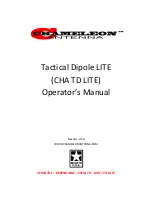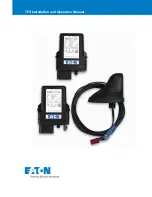
CHA TD LITE
Page 3
Introduction
Thank you for purchasing and using the Chameleon Antenna
TM
Tactical Dipole LITE (CHA TD LITE) antenna. The
CHA TD LITE is a broadband High Frequency (HF) antenna specially designed for short to long range portable and
man-pack HF communication where rapid deployment and simplicity of operation are essential, but compactness
is primary. The antenna will operate from 1.8 - 54 MHz without any adjustment with a wide range antenna tuner.
The CHA TD LITE is ideal for military, government agencies, non-governmental organizations (NGOs), Military
Affiliate Radio System (MARS), Civil Air Patrol (CAP), Amateur Radio Emergency Service (ARES) / Radio Amateur
Civil Emergency Service (RACES), Salvation Army Team Emergency Radio Network (SATERN), and amateur radio
operators (hams) involved in field communication and disaster preparedness. The CHA TD LITE is configurable to
facilitate Near-Vertical Incident Sky wave (NVIS) communication and its broadband design supports Automatic Link
Establishment (ALE), frequency-hopping, and spread-spectrum modes when used with a wide range antenna tuner
or coupler. The CHA TD LITE can be deployed by the operator in the field in less than 15 minutes, using almost any
available support, with no masts or guying required. Antennas built by Chameleon Antenna
TM
are versatile,
dependable, stealthy, and built to last. Please read this operator’s manual so
that you may maximize the utility
you obtain from your CHA TD LITE.
HF Propagation
HF radio provides relatively inexpensive and reliable local, regional, national, and international voice and data
communication capability. It is especially suitable for undeveloped areas where normal telecommunications are
not available, too costly or scarce, or where the commercial telecommunications infrastructure has been damaged
by a natural disaster or military conflict.
Although HF radio is a reasonably reliable method of communication, HF radio waves propagate through a
complex and constantly changing environment and are affected by weather, terrain, latitude, time of day, season,
and the 11-year solar cycle. A detailed explanation of the theory of HF radio wave propagation is beyond the
scope of this operator’s manual, but an understanding of the
basic principles will help the operator decide what
frequency and which of the CHA TD LITE
’s configurations will support the
ir communication requirements.
HF radio waves propagate from the transmitting antenna to the receiving antenna using two methods: ground
waves and sky waves.
Ground waves are composed of direct waves and
surface waves. Direct waves travel directly from the
transmitting antenna to the receiving antenna when
they are within the radio line-of-sight. Typically, this
distance is 8 to 14 miles for field stations. Surface
waves follow the curvature of the Earth beyond the
radio horizon. They are usable, during the day and
under optimal conditions, up to around 90 miles, see
table (1). Low power, horizontal antenna
polarization, rugged or urban terrain, dense foliage,
or dry soil conditions can reduce the range very
significantly. The U.S. Army found that in the dense
jungles of Vietnam, the range for ground waves was
sometimes less than one mile.
Frequency Distance Frequency Distance
2 MHz
88 miles
14 MHz
33 miles
4 MHz
62 miles
18MHz
29 miles
7 MHz
47 miles
24 MHz
25 miles
10 MHz
39 miles
30 MHz
23 miles
Table 1. Maximum Surface Wave Range by Frequency.
Sky waves are the primary method of HF radio wave propagation. HF radio waves on a frequency below the critical
frequency (found by an ionosonde) are reflected off one of the layers of the ionosphere and back to Earth between
300 and 2,500 miles, depending upon the frequency and ionospheric conditions. HF radio waves can then be




































